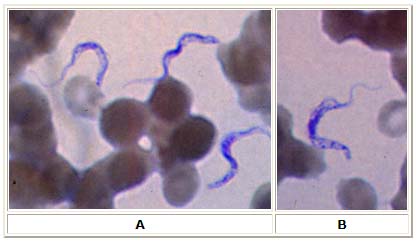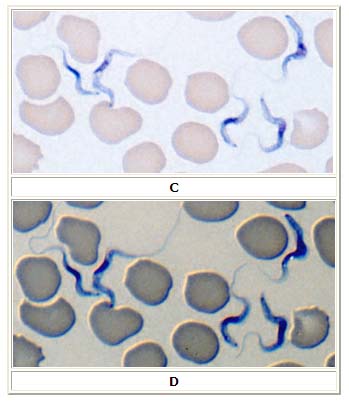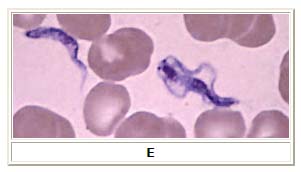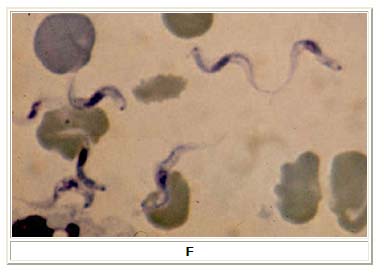African trypanosomiasis laboratory findings
|
African trypanosomiasis Microchapters |
|
Diagnosis |
|---|
|
Treatment |
|
Case Studies |
|
African trypanosomiasis laboratory findings On the Web |
|
American Roentgen Ray Society Images of African trypanosomiasis laboratory findings |
|
Risk calculators and risk factors for African trypanosomiasis laboratory findings |
Editor-In-Chief: C. Michael Gibson, M.S., M.D. [1]; Associate Editor(s)-In-Chief: Pilar Almonacid
Laboratory Findings
Electrolyte and Biomarker Studies
Three serological tests are available for detection of the parasite; the micro-CATT, wb-CATT, and wb-LATEX. The first uses dried blood while the other two use whole blood samples. A 2002 study found the wb-CATT to be the most efficient for diagnosis, while the wb-LATEX is a better exam for situations where greater sensitivity is required.[1]
Microscopy
A wet preparation should be examined for the motile trypanosomes, and in addition a smear should be fixed, stained with Giemsa (or Field), and examined. Concentration techniques can be used prior to microscopic examination. For blood samples, these include centrifugation followed by examination of the buffy coat; mini anion-exchange/centrifugation; and the Quantitative Buffy Coat (QBC) technique. For other samples such as spinal fluid, concentration techniques include centrifugation followed by examination of the sediment. Isolation of the parasite by inoculation of rats or mice is a sensitive method, but its use is limited to T. b. rhodesiense. Antibody detection has sensitivity and specificity that are too variable for clinical decisions. In addition, in infections with T. b. rhodesiense, seroconversion occurs after the onset of clinical symptoms and thus is of limited use.

A, B: Two areas from a blood smear from a patient with African trypanosomiasis. Thin blood smear stained with Giemsa. Typical trypomastigote stages (the only stages found in patients), with a posterior kinetoplast, a centrally located nucleus, an undulating membrane, and an anterior flagellum. The two T. brucei species that cause human trypanosomiasis, T. b. gambiense and T. b. rhodesiense, are indistinguishable morphologically. The trypanosomes length range is 14 to 33 µm.

C, D: Blood smear from a patient with T. b. rhodesiense, Giemsa stain. D shows the same field as C, with the addition of differential interference contrast (DIC) which better visualizes the flagella (DIC is not necessary for diagnosis!). 41-year-old man who had returned from a trip to Tanzania. Specimen contributed by Dr. Phil Smith, Omaha, Nebraska.

E: Blood smear from a patient (a U.S. traveler) with T. b. rhodesiense. A dividing parasite is seen at the right. Dividing forms are seen in African trypanosomiasis, but not in American trypanosomiasis (Chagas disease).

F: Blood smear from a patient with T. b. gambiense. Image contributed by Prof. J. Le Bras, Hôpital Bichat - Claude Bernard, Paris, France.
References
- ↑ Truc P, Lejon V, Magnus E; et al. (2002). "Evaluation of the micro-CATT, CATT/Trypanosoma brucei gambiense, and LATEX/T b gambiense methods for serodiagnosis and surveillance of human African trypanosomiasis in West and Central Africa". Bull. World Health Organ. 80 (11): 882–6. PMC 2567684. PMID 12481210.